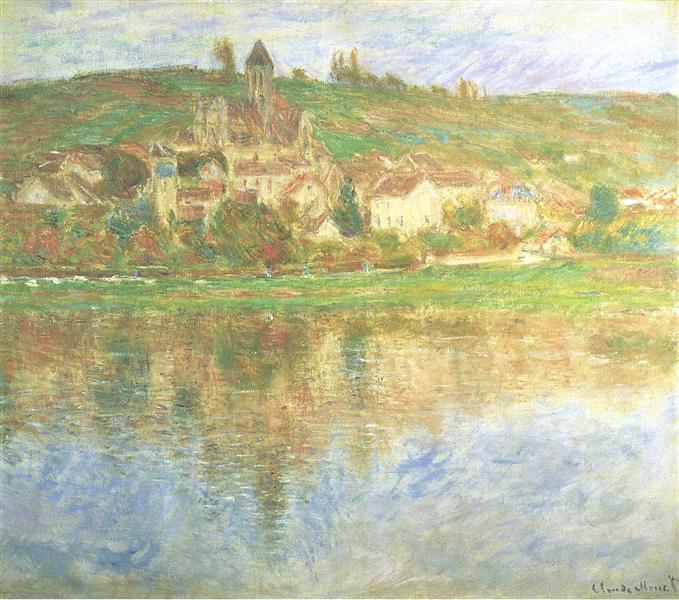Descriere
„Vétheuil” (1901) de Claude Monet este o mărturie sublimă a măiestriei impresioniste a creatorului său, care de -a lungul carierei sale a dedicat o abordare singulară a luminii, culorii și atmosferei. Monet, unul dintre pionierii impresionismului, a găsit în peisajul francez o sursă inepuizabilă de inspirație. Acest tablou nu numai că reprezintă o scenă specifică, dar invită privitorul să se cufunde în calitățile efemere ale naturii și în subtilitățile percepției vizuale.
Imaginea arată o vedere asupra orașului Vétheuil, care se află pe țărmurile râului Sena, un loc unde Monet ar petrece perioade de liniște și reflecție. În compoziție, râul curge senin spre orizont și este flancat de copaci și clădiri care arată timid. Această alegere atentă a elementelor creează un echilibru vizual în care peisajul și cerul par să fie împletite, evocând un sentiment de continuitate și calm.
Culoarea este unul dintre cele mai proeminente aspecte ale acestei lucrări. Monet folosește o paletă moale care predomină în tonuri albastre și verzi, contrastate de atingeri galbene și portocalii care sugerează prezența luminii naturale. Acest tratament de culoare reflectă lumina soarelui care este defalcată în apă, creând sclipiri care ghidează vederea și imaginația. Combinația dintre culorile pastelate și tehnica perii liberi este caracteristică stilului matur al lui Monet, unde forma este sugerată mai mult decât definită, lăsând o esență poetică în loc în locul unui portret literal.
În ceea ce privește personajele, „Vétheuil” pare a fi dezbrăcat de prezența umană. Spre deosebire de alte lucrări Monet în care figura umană încorporează o narațiune sau un context suplimentar, aici artistul optează pentru singurătatea peisajului, sugerând poate o dorință de introspecție. Această golire a figurilor umane permite privitorului să nu fie distras și se poate bucura pe deplin de contemplarea mediului natural, subliniind chiar mai mult conexiunea ființei umane cu natura.
Lucrarea din 1901 este înscrisă într -o perioadă a vieții lui Monet, care a fost marcată de o schimbare către o reprezentare mai „intensă” a culorii și a peisajului. Această perioadă se caracterizează și printr -o experimentare cu lumina și culoarea care va duce la seria sa de nevoie, care le va ocupa în curând atenția. „Vétheuil” este o punte către această nouă fază a creației, o lucrare care anticipează preocupările estetice și emoționale pe care Monet le -ar surprinde în compozițiile sale ulterioare.
Pictura este, de asemenea, un exemplu extraordinar de utilizare a spațiului. Monet folosește perspectiva nu numai pentru a crea profunzime vizuală, ci și pentru a evoca un sentiment de imensitate în peisaj. Orizontul se extinde aproape infinit, sugerând o lume dincolo de cadrul picturii, care este o caracteristică distinctivă a impresionismului care a invitat contemplația și imersiunea privitorului în natură.
„Vétheuil” este în cele din urmă, mai mult decât o reprezentare a unui loc specific. Este o reflecție asupra luminii, culorilor și experienței vizuale în contextul peisajului care a ocupat întotdeauna un loc central în munca lui Monet. Atunci când contemplăm lucrarea, devine evident că este o sărbătoare a momentului prezent, o clipă capturată în timp în care natura este dezvăluită în forma sa cea mai pură și sublimă. De -a lungul carierei sale, Monet va continua să exploreze aceste interacțiuni între lumină și peisaj, dar „vétheuil” este un preludiu fascinant al libertății sale artistice recent descoperite.
KUADROS ©, o vopsea faimoasă pe peretele tău.
Picturi de ulei realizate manual, cu calitatea artiștilor profesioniști și sigiliul distinctiv al KUADROS ©.
Imagini Serviciu de reproducere cu garanție de satisfacție. Dacă nu sunteți complet mulțumit de replica tabloului dvs., vă rambursăm banii 100%.

